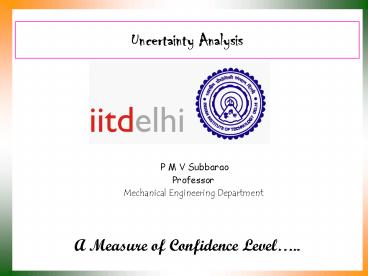Uncertainty Analysis - PowerPoint PPT Presentation
1 / 12
Title:
Uncertainty Analysis
Description:
Uncertainty Analysis P M V Subbarao Professor Mechanical Engineering Department A Measure of Confidence Level .. The Uncertainty The uncertainty of the measurement ... – PowerPoint PPT presentation
Number of Views:197
Avg rating:3.0/5.0
Title: Uncertainty Analysis
1
Uncertainty Analysis
- P M V Subbarao
- Professor
- Mechanical Engineering Department
A Measure of Confidence Level..
2
The Uncertainty
- The uncertainty of the measurement result y
arises from the uncertainties u (xi) (or ui for
brevity) of the input estimates xi that enter
equation. - Types of uncertainty may be categorized according
to the method used to evaluate them.
3
Components of Uncertainty
- Component of uncertainty arising from a random
effect Type A - These are evaluated by statistical methods.
- Component of uncertainty arising from a
systematic effect, Type B - These are evaluated by other means.
4
Representation of uncertainty components
- Standard UncertaintyEach component of
uncertainty, is represented by an estimated
standard deviation, termed standard uncertainty
ui, and equal to the positive square root of the
estimated variance - Standard uncertainty Type AAn uncertainty
component obtained by a Type A evaluation is
represented by a statistically estimated standard
deviation si, - Equal to the positive square root of the
statistically estimated variance si2. - For such a component the standard uncertainty is
ui si.
5
Standard uncertainty Type B
- This uncertainty is represented by a quantity uj
, - May be considered as an approximation to the
corresponding standard deviation which is it is
equal to the positive square root of uj2. - uj2 may be considered an approximation to the
corresponding variance si2 and which is obtained
from an assumed probability distribution based on
all the available information. - Since the quantity uj2 is treated like a variance
and uj like a standard deviation, - for such a component the standard uncertainty is
simply uj.
6
Evaluating uncertainty components Type B
- A Type B evaluation of standard uncertainty is
usually based on scientific judgment using all of
the relevant information available, which may
include - previous measurement data,
- experience with, or general knowledge of, the
behavior and property of relevant materials and
instruments, - manufacturer's specifications,
- data provided in calibration and other reports,
and - uncertainties assigned to reference data taken
from handbooks. - Broadly speaking, the uncertainty is either
obtained from an outside source, or obtained from
an assumed distribution.
7
Uncertainty obtained from an outside source
- Procedure Convert an uncertainty quoted in a
handbook, manufacturer's specification,
calibration certificate, etc., - Multiple of a standard deviation
- A stated multiple of an estimated standard
deviation to a standard uncertainty. - Confidence interval
- This defines a "confidence interval" having a
stated level of confidence, such as 95 or 99 ,
to a standard uncertainty.
8
Uncertainty obtained from an assumed distribution
- Normal distribution "1 out of 2"
- Procedure Model the input quantity in question
by a normal probability distribution. - Estimate lower and upper limits a- and a such
that the best estimated value of the input
quantity is (a a-)/2 - There is 1 chance out of 2 (i.e., a 50
probability) that the value of the quantity lies
in the interval a- to a. - Then uj is approximately 1.48 a, where a (a -
a-)/2 is the half-width of the interval.
9
Uncertainty obtained from an assumed distribution
- Normal distribution "2 out of 3"
- Procedure Model the input quantity in question
by a normal probability distribution. - Estimate lower and upper limits a- and a such
that the best estimated value of the input
quantity is (a a-)/2 - and there are 2 chances out of 3 (i.e., a 67
probability) that the value of the quantity lies
in the interval a- to a. - Then uj is approximately a, where a (a - a-)/2
is the half-width of the interval
10
Normal distribution "99.73 "
- Procedure If the quantity in question is
modeled by a normal probability distribution,
there are no finite limits that will contain 100
of its possible values. - Plus and minus 3 standard deviations about the
mean of a normal distribution corresponds to
99.73 limits. - Thus, if the limits a- and a of a normally
distributed quantity with mean (a a-)/2 are
considered to contain "almost all" of the
possible values of the quantity, - that is, approximately 99.73 of them, then uj
is approximately a/3, - where a (a - a-)/2 is the half-width of the
interval.
11
For a normal distribution, u encompases about
68 of the distribution for a uniform
distribution, u encompasses about 58 of the
distribution and for a triangular distribution,
u encompasses about 65 of the distribution.
12
Propagation of Uncertainty in Independent
Measurements































